

Billy the Kid
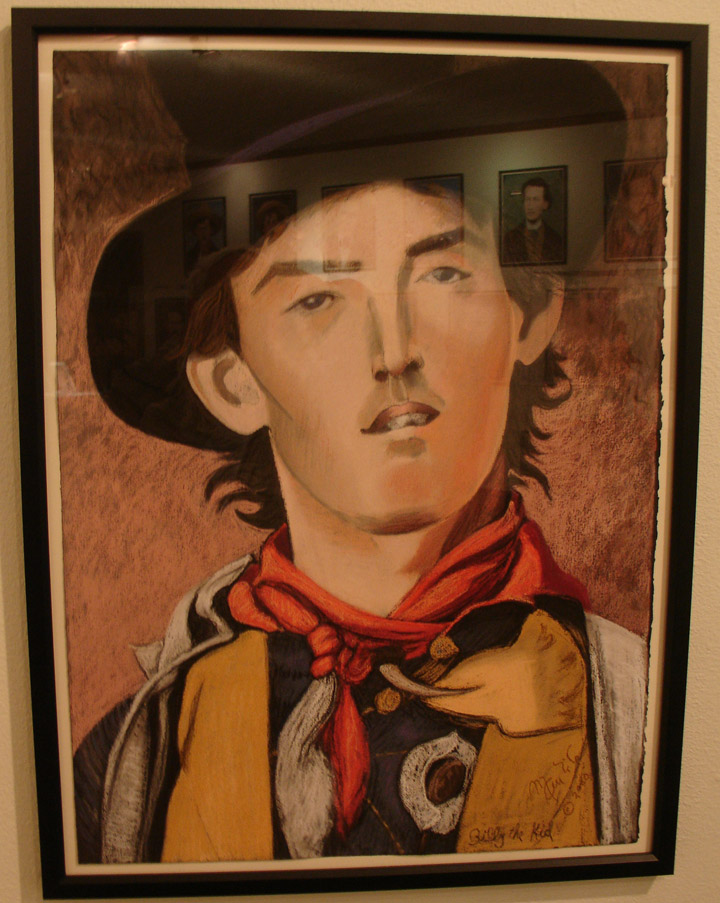
Billy the Kid
Henry McCarty (November 23, 1859 –
July 14, 1881), better known as Billy the Kid, but also known by the aliases
Henry Antrim and William H. Bonney, was a famous 19th century American frontier
outlaw and gunman who was a participant in the Lincoln County War. According to
legend he killed 21 men, one for each year of his life, but more likely he
participated in the killing of less than half that number.
McCarty (or Bonney, the name he used at the height of his notoriety) was
5'8"-5'9" (173-175 cm) with blue eyes, smooth cheeks, and prominent front teeth.
He was said to be friendly and personable at times, but he could also be
short-tempered and determined. This made him a very dangerous outlaw, when
combined with his shooting skills and cunning. He was also famous for
(apparently) always wearing a sugarloaf sombrero hat with a wide green
decorative band. He was little known in his own lifetime but was catapulted into
legend in the year after his death when his killer, Sheriff Patrick Garrett,
published a wildly sensationalistic biography of him called The Authentic Life
of Billy, the Kid. Beginning with Garrett's account, Billy the Kid grew into a
symbolic figure of the American Old West.
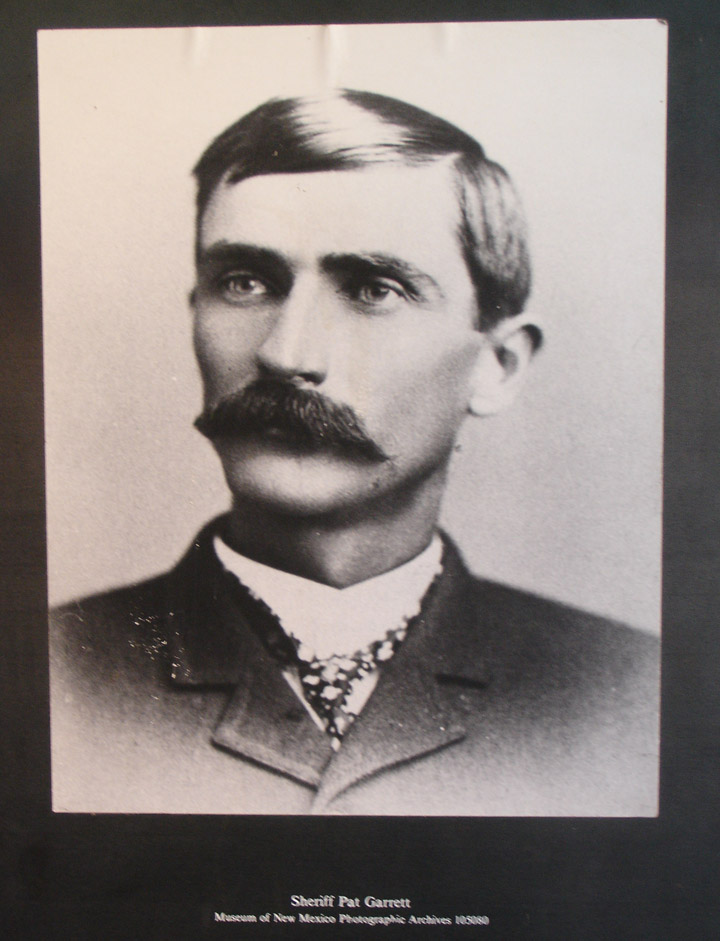
Sheriff Patrick Garrett
Little is known about Bonney's background, but he is thought to have been born
on Allen Street on the lower east side of Manhattan Island, New York. His
parents were of Irish Catholic descent, but their names, and thus Bonney's
surname, are not known for certain. Variations for his parents' names include
Catherine McCarty or Katherine McCarty Bonney for his mother and William Bonney
or Patrick Henry McCarty for his father (who probably died around the end of the
American Civil War). Some genealogists say he was born William Henry Bonney and
was son of William Harrison Bonney and wife Katherine Boujean, paternal grandson
of Levi Bonney and wife Rhoda Pratt and great-grandson of Obadiah Pratt (Saybrook,
Connecticut, September 14, 1742 – Canaan, New York, March 2, 1797) and wife
Jemima Tolls (New Haven, Connecticut, August 11, 1754 – Washington, New York,
November 24, 1812) (who in turn were the grandparents of Mormon leader Parley P.
Pratt, making him and Bonney first cousins once removed.). In 1868, his mother
met William Antrim, and after several years of moving around the country with
Henry and his half-brother Joseph, the couple married and settled in Silver
City, New Mexico, in 1873. Antrim found sporadic work as a bartender and
carpenter but soon became more interested in prospecting and gambling for
fortune than in his wife and stepsons. Despite this, young McCarty sometimes
referred to himself by the surname "Antrim."
Faced with an indigent husband, McCarty's mother took in boarders in order to
provide for her sons. She was afflicted with tuberculosis, even though she was
seen by her boarders and neighbors as "a jolly Irish lady, full of life and
mischief." The following year, on September 16, 1874, she died, and was buried
in the Memory Lane Cemetery in Silver City. At age 14, McCarty was taken in by a
neighboring family who operated a hotel where he worked to pay for his keep. The
manager was impressed by the youth, boasting that he was the only young man who
ever worked for him that did not steal anything. His school teachers said that
the young orphan was "no more of a problem than any other boy, always quite
willing to help with chores around the schoolhouse."
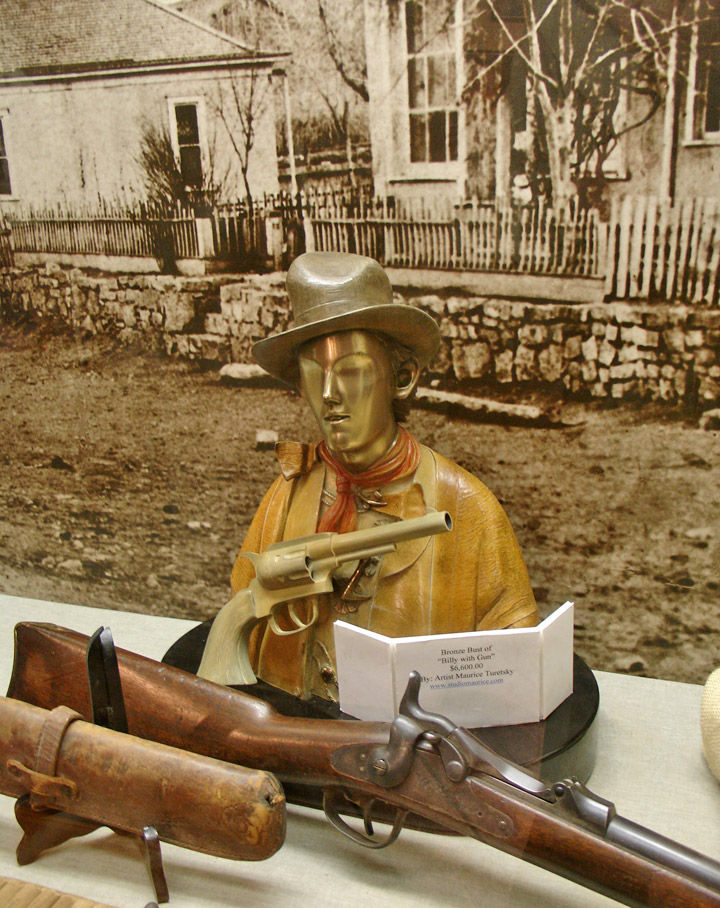
On September 24, 1875, McCarty was arrested for hiding a bundle of stolen
clothes for a man playing a prank on a Chinese laundryman. Two days after
McCarty was thrown in jail, the scrawny teen escaped by worming his way up the
jailhouse chimney. From that point on, McCarty was more or less a fugitive. He
eventually found work as an itinerant ranch hand and shepherd in southeastern
Arizona. In 1877, he became a civilian teamster at Fort Grant Army Post in
Arizona with the duty of hauling logs from a timber camp to a sawmill. The
civilian blacksmith at the camp, Frank "Windy" Cahill, took pleasure in bullying
young McCarty. On August 17, Cahill attacked McCarty after a verbal exchange and
threw him to the ground. McCarty retaliated by drawing his gun and shooting
Cahill, who died the next day. Once again McCarty was in custody, this time in
the Camp's guardhouse awaiting the arrival of the local marshal. Before the
marshal could arrive, however, McCarty escaped. It has sometimes been reported
that the encounter with Frank Cahill took place in a saloon.
Again on the run, McCarty, who had begun to refer to himself as "Willam H.
Bonney", next turned up in the house of Heiskell Jones in Pecos Valley, New
Mexico. Apaches had stolen McCarty's horse, which forced him to walk many miles
to the nearest settlement, which was the Jones's home. She nursed the young man,
who was near death, back to health. The Jones family developed a strong
attachment to McCarty and gave him one of their horses.
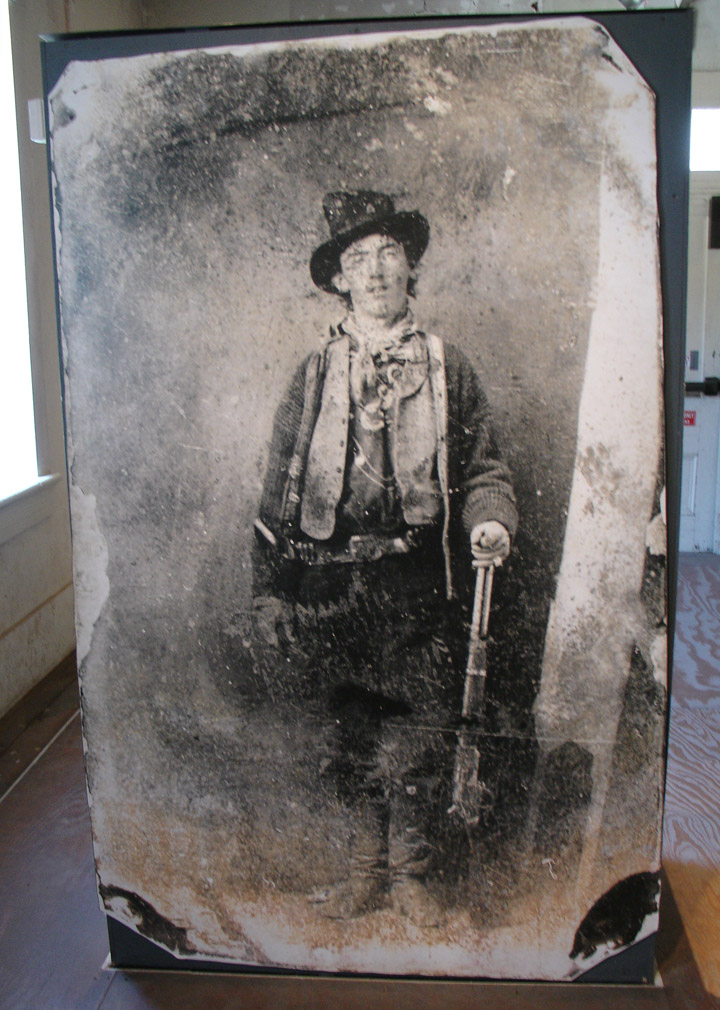
Billy the Kid
In the autumn of 1877, Bonney (McCarty) moved to Lincoln County, New Mexico, and
was hired as a cattle guard by John Tunstall, an English cattle rancher, banker
and merchant, and his partner, Alexander McSween, a prominent lawyer. A
conflict, known later as the Lincoln County War, had begun between the
established town merchants and the ranchers. Events turned bloody on February
18, 1878, when Tunstall, unarmed, was caught on an open range while herding
cattle and murdered. Tunstall's murder enraged Bonney and the other ranch hands.
They formed their own group called the Regulators, led by ranch hand Richard
"Dick" Brewer, and proceeded to hunt down two of the members of the posse that
had killed Tunstall. They captured Bill Morton and Frank Baker on March 6 and
killed them on March 9 near Agua Negra. While returning to Lincoln they also
killed one of their own members, a man named McCloskey, whom they suspected of
being a traitor.
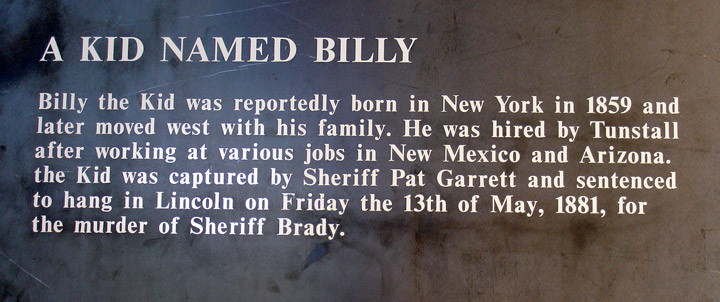
On April 1, Regulators Jim French, Frank McNab, John Middleton, Fred Waite,
Henry Brown and Bonney ambushed Sheriff William J. Brady[5] and his deputy,[6]
George W. Hindman killing them both in the high street of Lincoln itself. Bonney
was wounded while trying to retrieve a rifle belonging to him, which Brady had
taken in an earlier arrest.
On April 4, they tracked down and killed an old buffalo hunter known as Buckshot
Roberts, whom they suspected of involvement in the Tunstall murder, but not
before Roberts shot and killed Dick Brewer, who had been the Regulators' leader
up until that point. Two other Regulators were wounded during the gun battle,
which took place at Blazer's Mill. Under indictment for the Brady killing, Bonney and his gang spent the next several months in hiding and were trapped,
along with McSween, in McSween's home in Lincoln on July 15, 1878, by members of
"The House" and some of Brady's men. After a five-day siege, McSween's house was
set on fire. Bonney and the other Regulators fled, Bonney killing a "House"
member named Bob Beckwith in the process and maybe more. McSween was shot down
while fleeing the blaze, and his death essentially marked the end of the Lincoln
County Cattle War.
In the autumn of 1878, former Union Army General Lew Wallace became Governor of
the New Mexico Territory. In order to restore peace to Lincoln County, Wallace
proclaimed an amnesty for any man involved in the Lincoln County War who was not
already under indictment. Bonney, who had fled to Texas after escaping from
McSween's house, was under indictment, but Wallace was intrigued by rumors that
the young man was willing to surrender himself and testify against other
combatants if amnesty could be extended to him. In March 1879 Wallace and Bonney
met in Lincoln County to discuss the possibility of a deal. True to form, Bonney
greeted the governor with a revolver in one hand and a Winchester rifle in the
other. After taking several days to consider Wallace's offer, Bonney agreed to
testify in return for amnesty.
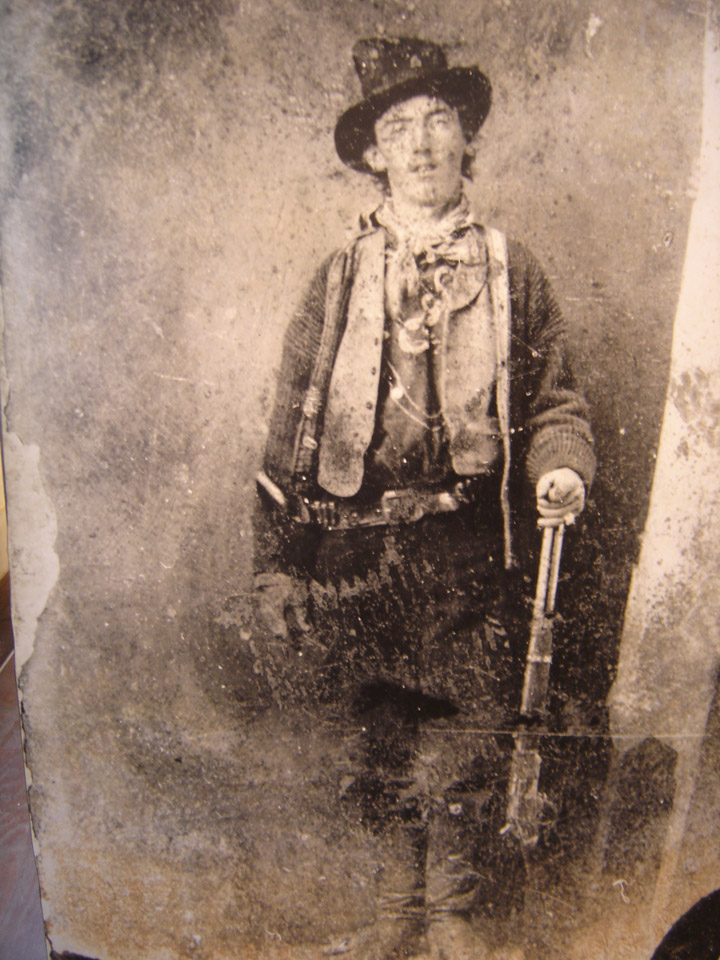
The arrangement called for Bonney to submit to a token arrest and a short stay
in jail until the conclusion of his courtroom testimony. Although Bonney's
testimony helped to indict John Dolan, the district attorney, one of the
powerful "House" faction leaders, disregarded Wallace's order to set Bonney free
after testifying. He was returned to jail in June 1879, but slipped out of his
handcuffs and fled.
For the next year and a half, Bonney survived by rustling, gambling and killing.
In January 1880, during a well-documented altercation, he killed a man named Joe
Grant in a Fort Sumner saloon. Grant was boasting that he would kill the "Kid"
if he saw him, not realizing the man he was playing poker with was "Billy the
Kid." In those days people only loaded their revolvers with five bullets, since
there were no safeties and a lot of accidents. The "Kid" asked Grant if he could
see his ivory handled revolver and, while looking at the weapon, cycled the
cylinder so the hammer would fall on the empty chamber. He then let Grant know
who he was. When Grant fired, nothing happened, and Bonney then shot him. When
asked about the incident later, he remarked, "It was a game for two, and I got
there first". Other stories tell the bullet issue differently. One version is
that Billy emptied the gun. Another story tells that Grant just bought the six
shot from another man, Chisum cowboy Jack Finan, who just some hours before had
shot three rounds without reloading. Grant hadn't reloaded the weapon either, as
he didn't know about that. The Kid only turned the empty cartridges up to the
hammer.
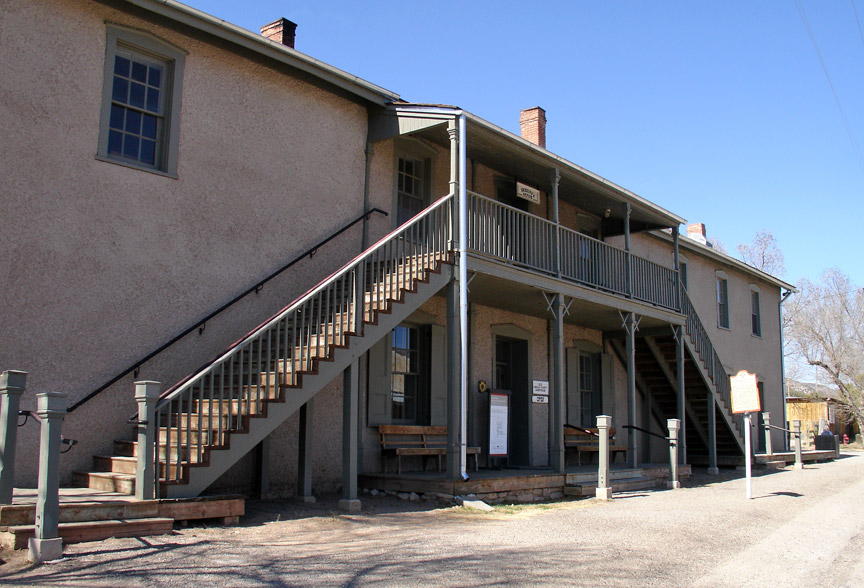
the courthouse, Lincoln, New Mexico
In November 1880, a posse pursued and trapped Bonney's gang inside a ranch house
(owned by friend James Greathouse at Anton Chico in the White Oaks area). A
posse member named James Carlysle ventured into the house under white flag in an
attempt to negotiate the group's surrender, with Greathouse being sent out as a
hostage for the posse. At some point in the night it became apparent to Carlysle
that the outlaws were stalling, when suddenly a shot was accidentally fired from
outside. Carlysle, assuming the posse members had shot Greathouse, decided to
run for his life, crashing through a window into the snow outside. As he did so,
the posse, mistaking Carlysle for one of the gang, fired and killed him.
Realizing what they had done and now demoralized, the posse scattered, allowing
Bonney and his gang to slip away. Bonney later wrote to Governor Wallace
claiming innocence in the killing of Carlysle and of involvement in cattle
rustling in general.
During this time, the Kid also developed a friendship with an ambitious local
bartender and former buffalo hunter named Pat Garrett. Running on a pledge to
rid the area of rustlers, Garrett was elected as sheriff of Lincoln County in
November 1880, and in early December he put together a posse and set out to
arrest Bonney, now known almost exclusively as Billy the Kid, and carrying a
$500 bounty on his head.
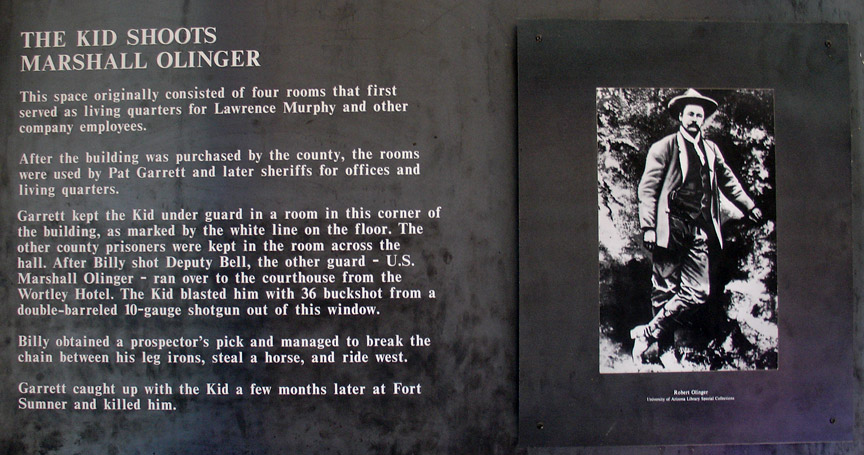
The posse led by Garrett fared much better, and his men closed in quickly. On
December 19, Bonney barely escaped the posse's midnight ambush in Fort Sumner,
during which one of the gang, Tom O'Folliard, was shot and killed. On December
23, he was tracked to an abandoned stone building located in a remote location
called Stinking Springs. While Bonney and his gang were asleep inside, Garrett's
posse surrounded the building and waited for sunrise. The next morning, a cattle
rustler named Charlie Bowdre stepped outside to feed his horse. Mistaken for
Bonney, he was killed by the posse. Soon afterward somebody from within the
building reached for the horse's halter rope, but Garrett shot and killed the
horse, the body of which then blocked the only exit. As the lawmen began to cook
breakfast over an open fire, Garrett and Bonney engaged in a friendly exchange,
with Garrett inviting Bonney outside to eat, and Bonney inviting Garrett to "go
to hell." Realizing that they had no hope of escape, the besieged and hungry
outlaws finally surrendered later that day and were allowed to join in the meal.
Bonney was jailed in the town of Mesilla while waiting for his April 1881 trial
and spent his time giving newspaper interviews and also peppering Governor
Wallace with letters seeking clemency. Wallace, however, refused to intervene.
Bonney's trial took one day and resulted in his conviction for the murder of
Sheriff Brady: the only conviction ever secured against any of the combatants in
the Lincoln County Cattle War. On April 13, he was sentenced by Judge Warren
Bristol to hang. The execution was scheduled for May 13, and he was sent to
Lincoln to await this date, held under guard by two of Garrett's deputies, James
Bell and Robert Ollinger, on the top floor of the town's courthouse. On April
28, while Garrett was out of town, Bonney stunned the territory by killing both
of his guards and escaping.
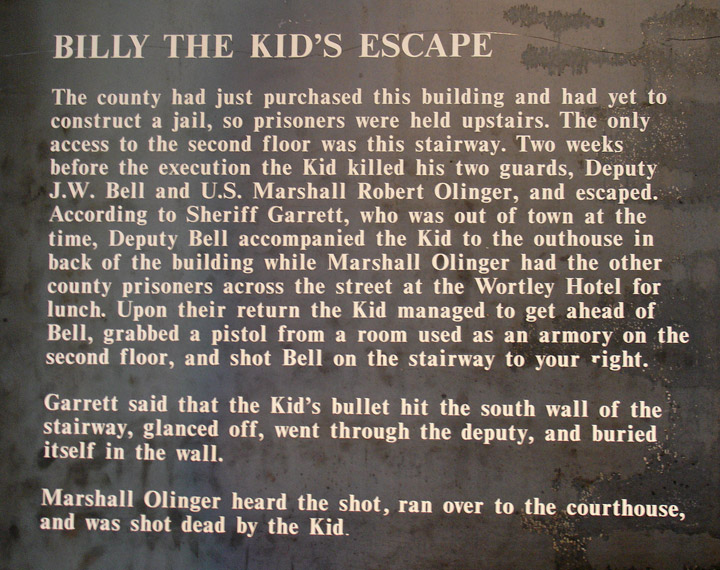
The details of the escape are unclear. Some historians believe that a friend or
Regulator sympathizer left a pistol in a nearby privy that Bonney was allowed to
use, under escort, each day. Bonney then retrieved this gun and after Bell had
led him back to the courthouse, turned it on his guard as the two of them
reached the top of a flight of stairs inside. Another theory holds that Bonney
slipped his manacles at the top of the stairs, struck Bell over the head with
them and then grabbed Bell's own gun and shot him.
However it happened, Bell staggered out into the street and collapsed, mortally
wounded. Meanwhile, Bonney scooped up Ollinger's ten-gauge double barrel
shotgun and waited at the upstairs window for Ollinger, who had been across the
street with some other prisoners, to come to Bell's aid. As Ollinger came
running into view, Bonney leveled the shotgun at him, called out "Hello Bob!"
and shot him dead. The townsfolk supposedly gave him an hour that he used to
remove his leg iron. The hour was granted in thanks for his work as part of "The
Regulators." After cutting his leg irons with an axe, the young outlaw borrowed
(or stole) a horse and rode leisurely out of town, reportedly singing. The horse
was returned two days later.
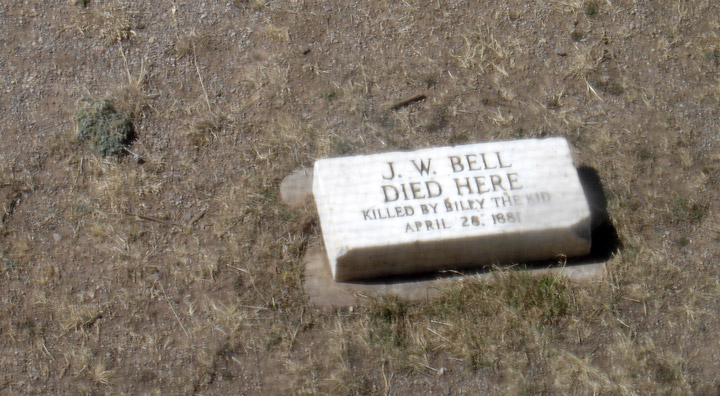
Responding to rumors that Bonney was still lurking in the vicinity of Fort
Sumner almost three months after his escape, Sheriff Garrett and two deputies
set out on July 14, 1881, to question one of the town's residents, a friend of
Bonney's named Pedro Maxwell (son of land baron Lucien Maxwell). Near midnight,
as Garrett and Maxwell sat talking in Maxwell's darkened bedroom, Bonney
unexpectedly entered the room. There are at least two versions of what happened
next.
One version says that as the Kid entered, he could not recognize Garrett in the
poor light. Bonney drew his pistol and backed away, asking "¿Quién es? ¿Quién es?"
(Spanish for "Who is it? Who is it?"). Recognizing Bonney's voice, Garrett drew
his own pistol and fired twice, the first bullet hitting Bonney just above his
heart, killing him. In a second version, Bonney entered carrying a knife,
evidently headed to a kitchen area. He noticed someone in the darkness, and
uttered the words "¿Quién es? ¿Quién es?" at which point he was shot and killed
in ambush style.
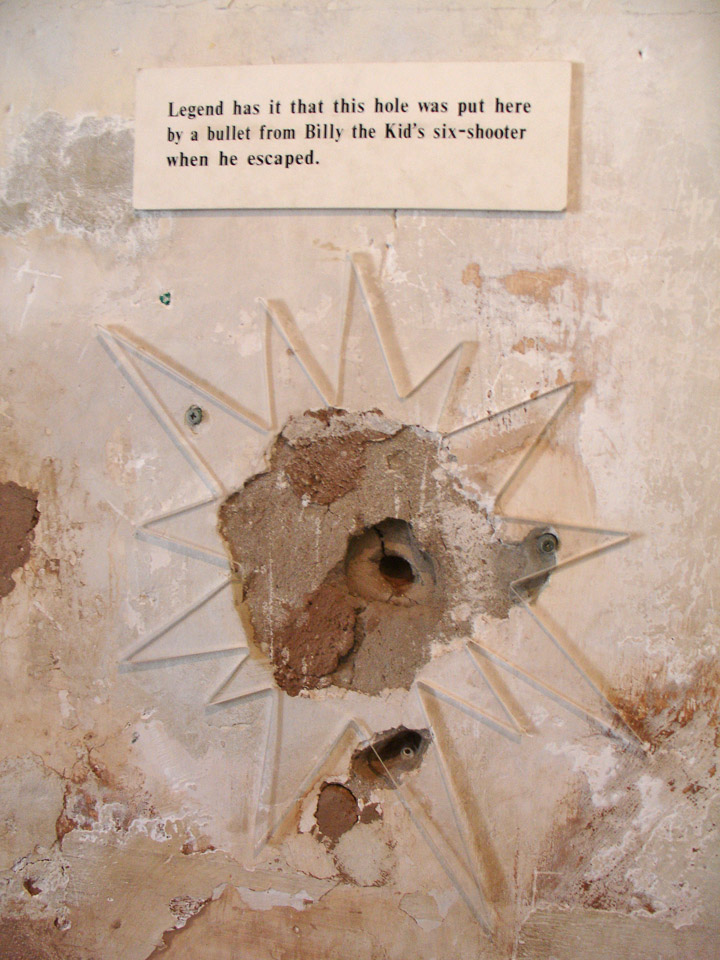
Although the popularity of the first story persists, and portrays Garrett in a
better light, many historians contend that the second version is probably the
accurate one. A markedly different theory, in which Garrett and his
posse set a trap for Bonney, has also been suggested, most recently being
investigated in the Discovery Channel documentary "Billy the Kid: Unmasked." The
theory contends that Garrett went to the bedroom of Pedro Maxwell's sister,
Paulita, and tied up and gagged her in her bed. Paulita was an acquaintance of
Billy the Kid, and the two had possibly considered getting married. When Bonney
arrived, Garrett was waiting behind Paulita's bed and shot the Kid.
Henry McCarty, alias Henry Antrim, alias William H. Bonney, alias Billy the Kid,
was buried the next day in Fort Sumner's old military cemetery, between his
fallen companions Tom O'Folliard and Charlie Bowdre. A single tombstone was
later erected over the graves, giving the three outlaws' names and with the word
"Pals" also carved into it. The tombstone has been stolen and recovered three
times since being placed in the 1940s, and the entire gravesite is now enclosed
by a steel cage.
Text from Wikipedia
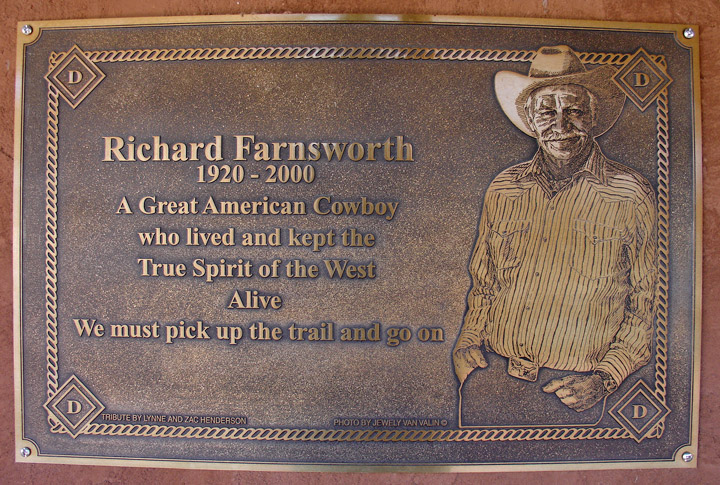
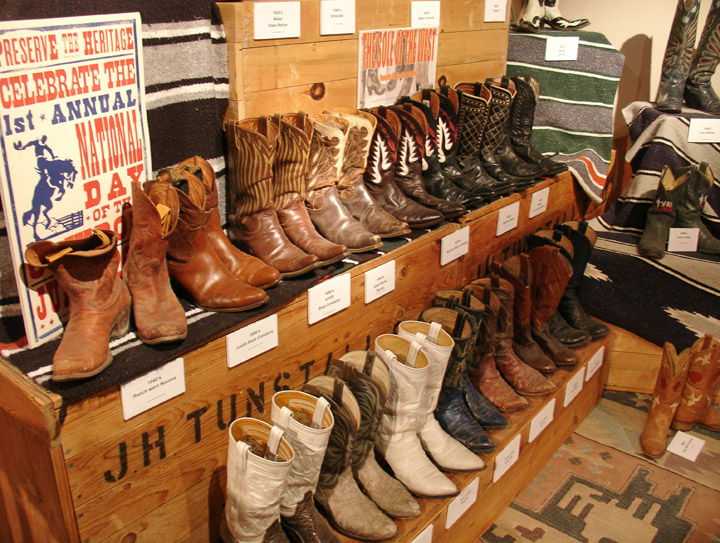
Boots